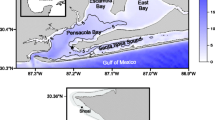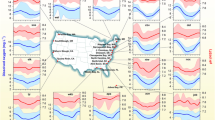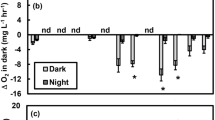Abstract
Twenty-three station-years of diel oxygen data for the James River Estuary were analyzed to characterize longitudinal, seasonal, and interannual patterns of gross primary production (GPP) and ecosystem respiration (ER). We compared two commonly used methods for deriving metabolism (bookkeeping and Bayesian) to determine whether the observed patterns were robust with respect to computational methodology. The two methods revealed similar longitudinal patterns of increasing GPP and ER, and decreasing net ecosystem metabolism (NEM), with increasing salinity. Seasonal patterns in GPP and ER tracked water temperature and solar radiation, except during high discharge events when metabolism declined by 40%. The bookkeeping method yielded higher estimates of GPP and ER in the higher end of the range, and smaller estimates in the low end of the range, thereby accentuating seasonal and longitudinal differences. Inferences regarding net autotrophy and heterotrophy were robust, as both methods yielded positive estimates of NEM at the chlorophyll maximum (tidal fresh segment) and negative values for the saline portion of the estuary. Inferences regarding the relative importance of allochthonous inputs (based on inferred ER at GPP = 0) differed between the two methods. Values derived by the bookkeeping method indicated that respiration was largely supported by autochthonous production, whereas the Bayesian results indicated that autochthonous and allochthonous inputs were equally important. Overall, our findings show that methodological differences were small in the context of longitudinal, seasonal, and interannual variation but that the bookkeeping method yielded a wider range of values for GPP and ER relative to the Bayesian estimates.










Similar content being viewed by others
References
Appling, A. P., R. O. Hall, M. Arroita, and C. B. Yackulic. 2017. streamMetabolizer: models for estimating aquatic photosynthesis and respiration. R package version 0.9.33. https://github.com/USGS-R/streamMetabolizer.
Aristegi, L., O. Izagirre, and A. Elosegi. 2009. Comparison of several methods to calculate reaeration in streams and their effects on estimation of metabolism. Hydrobiologia 635 (1): 113–124.
Beck, M.W., and R.R. Murphy. 2017. Numerical and qualitative contrasts of two statistical models for water quality change in tidal waters. Journal of the American Water Resources Association 53 (1): 197–219.
Berg, P., and M.L. Pace. 2017. Continuous measurement of air-water gas exchange by underwater eddy covariance. Biogeosciences 14 (23): 5595–5606.
Bernhardt, E.S., J.B. Heffernan, N.B. Grimm, E.H. Stanley, J.W. Harvey, et al. 2018. The metabolic regimes of flowing waters. Limnology and Oceanography 63: 99–118.
Borges, A.V. 2005. Do we have enough pieces of the jigsaw to integrate CO2 fluxes in the coastal ocean? Estuaries and Coasts 28 (1): 3–27.
Bott, T.L., D.S. Montgomery, J.D. Newbold, D.B. Arscott, C.L. Dow, A.K. Aufdenkampe, J.K. Jackson, and L.A. Kaplan. 2006. Ecosystem metabolism in streams of the Catskill Mountains (Delaware and Hudson River watersheds) and Lower Hudson Valley. Journal of the North American Benthological Society 25 (4): 1018–1044.
Boynton, W., W. Kemp, and C. Keefe. 1982. Estuarine comparisons: a comparative analysis of nutrients and other factors influencing estuarine phytoplankton production. Estuarine comparisons. New York: Academic.
Bricker, S., B. Longstaff, W. Dennison, A. Jones, K. Boicourt, C. Wicks, and J. Woerner. 2007. Effects of nutrient enrichment in the nation’s estuaries: a decade of change. Silver Spring: NOAA Coastal Ocean Program Decision Analysis (Series 26) National Centers for Coastal Ocean Science.
Bruesewitz, D.A., W.S. Gardner, R.F. Mooney, L. Pollard, and E.J. Buskey. 2013. Estuarine ecosystem function response to flood and drought in a shallow, semiarid estuary: nitrogen cycling and ecosystem metabolism. Limnology and Oceanography 58 (6): 2293–2309.
Bukaveckas, P.A., and W.N. Isenberg. 2013. Loading, transformation and retention of nitrogen and phosphorus in the tidal freshwater James River (Virginia). Estuaries and Coasts 36 (6): 1219–1236.
Bukaveckas, P.A., L.E. Barry, M.J. Beckwith, V. David, and B. Lederer. 2011. Factors determining the location of the chlorophyll maximum and the fate of algal production within the tidal freshwater James River. Estuaries and Coasts 34 (3): 569–582.
Bukaveckas, P.A., M. Beck, D. Devore, and W.M. Lee. 2018. Climatic variability and its role in regulating C, N and P retention in the James River Estuary. Estuarine, Coastal and Shelf Science 205: 161–173.
Caffrey, J.M. 2003. Production, respiration and net ecosystem metabolism in U.S. estuaries. Environmental Monitoring and Assessment 81 (1): 207–219.
Caffrey, J.M. 2004. Factors controlling net ecosystem metabolism in U.S. estuaries. Estuaries and Coasts 27 (1): 90–101.
Caffrey, J.M., M.C. Murrell, K.S. Amacker, J.W. Harper, S. Phipps, and M.S. Woodrey. 2014. Seasonal and inter-annual patterns in primary production, respiration, and net ecosystem metabolism in three estuaries in the northeast Gulf of Mexico. Estuaries and Coasts 37 (S1): 222–241.
Carignan, R., A. Blais, and C. Vis. 1998. Measurement of primary production and community respiration in oligotrophic lakes using the Winkler method. Canadian Journal of Fisheries and Aquatic Sciences 55 (5): 1078–1084.
Cloern, J.E., S. Foster, and A. Kleckner. 2014. Phytoplankton primary production in the world's estuarine-coastal ecosystems. Biogeosciences 11 (9): 2477–2501.
Cole, J.J., N.F. Caraco, and B.L. Peierls. 1992. Can phytoplankton maintain a positive carbon balance in a turbid, freshwater, tidal estuary? Limnology and Oceanography 37 (8): 1608–1617.
Cole, J.J., M.L. Pace, S.R. Carpenter, and J.F. Kitchell. 2000. Persistence of net heterotrophy in lakes during nutrient addition and food web manipulations. Limnology and Oceanography 45 (8): 1718–1730.
Collins, J.R., P.A. Raymond, W.F. Bohlen, and M.M. Howard-Strobel. 2013. Estimates of new and total productivity in Central Long Island Sound from in situ measurements of nitrate and dissolved oxygen. Estuaries and Coasts 36 (1): 74–97.
Cory, R. 1974. Changes in oxygen and primary production of the Patuxent estuary, Maryland, 1963 through 1969. Chesapeake Science 15 (2): 78–83.
Crosswell, J.R., M.S. Wetz, B. Hales, and H.W. Paerl. 2012. Air-water CO2 fluxes in the microtidal Neuse River Estuary, North Carolina. Journal of Geophysical Research: Oceans 117 (C8).
D'Avanzo, C., J.N. Kremer, and S.C. Wainright. 1996. Ecosystem production and respiration in response to eutrophication in shallow temperate estuaries. Marine Ecology Progress Series 4 (44): 263–274.
Deacon, E. 1981. Sea-air gas transfer: the wind speed dependence. Boundary-Layer Meteorology 21 (1): 31–37.
del Giorgio, P.A., and R.H. Peters. 1994. Patterns in planktonic P:R ratios in lakes: influence of lake trophy and dissolved organic carbon. Limnology and Oceanography 39 (4): 772–787.
Gazeau, F., J. Gattuso, J.J. Middelburg, N. Brion, L. Schiettecatte, M. Frankignoulle, et al. 2005. Planktonic and whole system metabolism in a nutrient-rich estuary (the Scheldt Estuary). Estuaries and Coasts 28 (6): 868–883.
Grace, M.R., D.P. Giling, S. Hladyz, V. Caron, R.M. Thompson, and R. Mac Nally. 2015. Fast processing of diel oxygen curves: Estimating stream metabolism with BASE (BAyesian Single-station estimation). Limnology and Oceanography: Methods 13 (3): 103–114.
Hall, R.O., J.L. Tank, M.A. Baker, E.J. Rosi-Marshall, and E.R. Hotchkiss. 2016. Metabolism, gas exchange, and carbon spiraling in rivers. Ecosystems 19 (1): 73–86.
Herrmann, M., R. Najjar, W.M. Kemp, R.B. Alexander, E.W. Boyer, W.-J. Cai, P.C. Griffith, K.D. Kroeger, S.L. McCallister, and R.A. Smith. 2015. Net ecosystem production and organic carbon balance of U.S. East Coast estuaries: a synthesis approach. Global Biogeochemical Cycles 29 (1): 96–111.
Ho, D.T., P. Schlosser, and P.M. Orton. 2011. On factors controlling air-water gas exchange in a large tidal river. Estuaries and Coast 34 (6): 1103–1116.
Hobbs, N.T., and M.B. Hooten. 2015. Bayesian models: a statistical primer for ecologists. Princeton: Princeton University Press.
Hoellein, T.J., D.A. Bruesewitz, and D.C. Richardson. 2013. Revisiting Odum (1956): a synthesis of aquatic ecosystem metabolism. Limnology and Oceanography 58 (6): 2089–2100.
Holtgrieve, G.W., D.E. Schindler, T.A. Branch, and Z.T. A'mar. 2010. Simultaneous quantification of aquatic ecosystem metabolism and reaeration using a Bayesian statistical model of oxygen dynamics. Limnology and Oceanography 55 (3): 1047–1063.
Hopkinson, C., and E.M. Smith. 2005. Estuarine respiration: an overview of benthic, pelagic, and whole system respiration. In Respiration in aquatic ecosystems, 122–146. New York: Academic.
Houser, J.N., L.A. Bartsch, W.B. Richardson, J.T. Rogala, and J.F. Sullivan. 2015. Ecosystem metabolism and nutrient dynamics in the main channel and backwaters of the upper Mississippi River. Freshwater Biology 60 (9): 1863–1879.
Jähne, B., K.O. Münnich, R. Bösinger, A. Dutzi, W. Huber, and P. Libner. 1987. On the parameters influencing air-water gas exchange. Journal of Geophysical Research:Oceans 92 (C2): 1937–1949.
Jassby, A.D., J.E. Cloern, and B.E. Cole. 2002. Annual primary production: patterns and mechanisms of change in a nutrient-rich tidal ecosystem. Limnology and Oceanography 47 (3): 698–712.
Kemp, W., E. Smith, M. Marvin-DiPasquale, and W. Boynton. 1997. Organic carbon balance and net ecosystem metabolism in Chesapeake Bay. Marine Ecology Progress Series 150: 229–248.
Lindeman, R.L. 1942. The trophic-dynamic aspect of ecology. Ecology 23 (4): 399–417.
Moore, K.A., D. Wilcox, and R.J. Orth. 2000. Analysis of the abundance of submersed aquatic vegetation communities in Chesapeake Bay. Estuaries 23 (1): 115–127.
Morton, R., and B.L. Henderson. 2008. Estimation of non-linear trends in water quality: an improved approach using generalized additive models. Water Resources Research 44 (7): W07420.
Murrell, M.C., J.M. Caffrey, D.T. Marcovich, M.W. Beck, B.M. Jarvis, and J.D. Hagy. 2018. Seasonal oxygen dynamics in a warm temperate estuary: effects of hydrologic variability on measurements of primary production, respiration and net metabolism. Estuaries and Coasts 41 (3): 690–707.
Muylaert, K., M. Tackx, and W. Vyverman. 2005. Phytoplankton growth rates in the freshwater tidal reaches of the Schelde Estuary (Belgium) estimated using a simple light-limited primary production model. Hydrobiologia 540 (1-3): 127–140.
O’Connor, D., and W. Dobbins. 1958. Mechanism of reaeration in natural streams. Transactions of the American Society of Civil Engineers 123: 641–684.
Obrador, B., P.A. Staehr, and J.P.C. Christensen. 2014. Vertical patterns of metabolism in three contrasting stratified lakes. Limnology and Oceanography 59 (4): 1228–1240.
Oczkowski, A., C.W. Hunt, M. Miller, C.A. Oviatt, S.W. Nixon, and L. Smith. 2016. Comparing measures of estuarine ecosystem production in a temperate New England estuary. Estuaries and Coasts 39 (6): 1827–1844.
Odum, H.T. 1956. Primary production in flowing waters. Limnology and Oceanography 1 (2): 102–117.
Paerl, H.W., K.L. Rossignol, S.N. Hall, B.L. Peierls, and M.S. Wetz. 2010. Phytoplankton community indicators of short-and long-term ecological change in the anthropogenically and climatically impacted Neuse River Estuary, North Carolina, USA. Estuaries and Coasts 33 (2): 485–497.
R Core Team. 2017. R: a language and environment for statistical computing. Vienna: R Foundation for Statistical Computing https://www.R-project.org/.
Raymond, P.A., and J.J. Cole. 2001. Gas exchange in rivers and estuaries: choosing a gas transfer velocity. Estuaries 24 (2): 312–317.
Raymond, P.A., J.E. Bauer, and J.J. Cole. 2000. Atmospheric CO2 evasion, dissolved inorganic carbon production, and net heterotrophy in the York River Estuary. Limnology and Oceanography 45 (8): 1707–1717.
Raymond, P.A., C.J. Zappa, D. Butman, T.L. Bott, J. Potter, P. Mulholland, et al. 2012. Scaling the gas transfer velocity and hydraulic geometry in streams and small rivers. Limnology and Oceanography: Fluids and Environments 2: 41–53.
Raymond, P.A., J. Hartmann, R. Lauerwald, S. Sobek, C. McDonald, M. Hoover, D. Butman, R. Striegl, E. Mayorga, C. Humborg, P. Kortelainen, H. Dürr, M. Meybeck, P. Ciais, and P. Guth. 2013. Global carbon dioxide emissions from inland waters. Nature 503 (7476): 355–359.
Richards, R., L. Hughes, D. Gee, and R. Tomlinson. 2013. Using generalized additive models for water quality assessments: a case study example from Australia. Journal of Coastal Research 65: 111–116.
Roelke, D.L., H. Li, C.J. Miller-DeBoer, G.M. Gable, and S.E. Davis. 2017. Regional shifts in phytoplankton succession and primary productivity in the San Antonio bay system (USA) in response to diminished freshwater inflows. Marine and Freshwater Research 68 (1): 131–145.
Sakamaki, T., J.Y.T. Shum, and J.S. Richardson. 2010. Watershed effects on chemical properties of sediment and primary consumption in estuarine tidal flats: Importance of watershed size and food selectivity by macrobenthos. Ecosystems 11: 328–337.
Sellers, T., and P.A. Bukaveckas. 2003. Phytoplankton production in a large, regulated river: a modeling and mass balance assessment. Limnology and Oceanography 48 (4): 1476–1487.
Shen, J., and J. Lin. 2006. Modeling study of the influences of tide and stratification on age of water in the tidal James River. Estuarine, Coastal and Shelf Science 68 (1-2): 101–112.
Shen, J., Y. Wang, and M. Sisson. 2016. Development of the hydrodynamic model for long-term simulation of water quality processes of the tidal James River, Virginia. Journal of Marine Science and Engineering 4 (4): 82.
Smith, E.M., and W.M. Kemp. 1995. Seasonal and regional variations in plankton community production and respiration for Chesapeake Bay. Marine Ecology Progress Series 116 (1): 217–231.
Solomon, C.T., D.A. Bruesewitz, D.C. Richardson, K.C. Rose, M.C. Van de Bogert, P.C. Hanson, et al. 2013. Ecosystem respiration: drivers of daily variability and background respiration in lakes around the globe. Limnology and Oceanography 58 (3): 849–866.
Staehr, P.A., J.M. Testa, W.M. Kemp, J.J. Cole, K. Sand-Jensen, and S.V. Smith. 2012. The metabolism of aquatic ecosystems: history, applications, and future challenges. Aquatic Sciences 74 (1): 15–29.
Strayer, D.L., M.L. Pace, N.F. Caraco, J.J. Cole, and S.E.G. Findlay. 2008. Hydrology and grazing jointly control a large-river food web. Ecology 89 (1): 12–18.
Testa, J.M., W.M. Kemp, C.S. Hopkinson, and S.V. Smith. 2012. Ecosystem metabolism. In In estuarine ecology 381–416. Hoboken: Wiley-Blackwell.
Thomann, R.V., and J.A. Mueller. 1987. Principles of surface water quality modeling and control. New York: Harper & Row.
Tomaso, D.J., and R.G. Najjar. 2015. Long-term variations in the dissolved oxygen budget of an urbanized tidal river: the upper Delaware Estuary. Journal of Geophysical Research Biogeosciences 120 (6): 1027–1045.
Tranvik, L.J., J.A. Downing, J.B. Cotner, S.A. Loiselle, R.G. Striegl, T.J. Ballatore, P. Dillon, K. Finlay, K. Fortino, L.B. Knoll, P.L. Kortelainen, T. Kutser, S. Larsen, I. Laurion, D.M. Leech, S.L. McCallister, D.M. McKnight, J.M. Melack, E. Overholt, J.A. Porter, Y. Prairie, W.H. Renwick, F. Roland, B.S. Sherman, D.W. Schindler, S. Sobek, A. Tremblay, M.J. Vanni, A.M. Verschoor, E. von Wachenfeldt, G.A. Weyhenmeyer, et al. 2009. Lakes and reservoirs as regulators of carbon cycling and climate. Limnology and Oceanography 54 (6.2): 2298–2314.
USEPA and Region III Chesapeake Bay Program Office. 2005. Chesapeake Bay program analytical segmentation scheme: revisions, decisions and rationales 1983–2003, 2005 addendum. Rep. No. EPA 903-R-05-004, Monitoring and Analysis Subcommittee, and Tidal Monitoring and Analysis Workgroup, Annapolis, Md.
Vannote, R.L., G.W. Minshall, K.W. Cummins, J.R. Sedell, and C.E. Cushing. 1980. The river continuum concept. Canadian Journal of Fisheries and Aquatic Sciences 37 (1): 130–137.
Vincent, W.F., J.J. Dodson, N. Bertrand, and J. Frenette. 1996. Photosynthetic and bacterial production gradients in a larval fish nursery: the St. Lawrence River transition zone. Marine Ecology Progress Series 139: 227–238.
Wanninkhof, R. 1992. Relationship between wind speed and gas exchange over the ocean. Journal of Geophysical Research: Oceans 97 (C5): 7373–7382.
Winslow, L.A., J.A. Zwart, R.D. Batt, H.A. Dugan, R.I. Woolway, J.R. Corman, P.C. Hanson, and J.S. Read. 2016. LakeMetabolizer: an R package for estimating lake metabolism from free-water oxygen using diverse statistical models. Inland Waters 6 (4): 622–636.
Wood, S.N. 2006. Generalized additive models: an introduction with R. London: Chapman and Hall CRC Press.
Wood, J.D., and P.A. Bukaveckas. 2014. Increasing severity of phytoplankton nutrient limitation following reductions in point source inputs to the tidal freshwater segment of the James River Estuary. Estuaries and Coasts 37 (5): 1188–1201.
Wood, J.D., D. Elliott, G. Garman, D. Hopler, W. Lee, S. McIninch, A.J. Porter, and P.A. Bukaveckas. 2016. Autochthony, allochthony and the role of consumers in influencing the sensitivity of aquatic systems to nutrient enrichment. Food Webs 7: 1–12.
Zwart, J.A., S.D. Sebestyen, C.T. Solomon, and S.E. Jones. 2017. The influence of hydrologic residence time on lake carbon cycling dynamics following extreme precipitation events. Ecosystems 20 (5): 1000–1014.
Acknowledgements
We are grateful to our colleagues at the Virginia Institute of Marine Science for making the longitudinal diel oxygen dataset available via their VECOS website and to the Virginia Department of Environmental Quality Piedmont and Tidewater Offices for collecting longitudinal water quality data. We thank Alison Appling (USGS) for her assistance with the Bayesian modeling and Jian Shen (VIMS) for providing model output on atmospheric exchange coefficients for the James. Ken Moore and Robert Orth (VIMS) provided data and helpful discussions on SAV. Three anonymous reviewers provided valuable comments. This paper is a contribution to the VCU Rice Rivers Center.
Author information
Authors and Affiliations
Corresponding author
Additional information
Communicated by: James L. Pinckney
Rights and permissions
About this article
Cite this article
Tassone, S.J., Bukaveckas, P.A. Seasonal, Interannual, and Longitudinal Patterns in Estuarine Metabolism Derived from Diel Oxygen Data Using Multiple Computational Approaches. Estuaries and Coasts 42, 1032–1051 (2019). https://doi.org/10.1007/s12237-019-00526-0
Received:
Revised:
Accepted:
Published:
Issue Date:
DOI: https://doi.org/10.1007/s12237-019-00526-0




